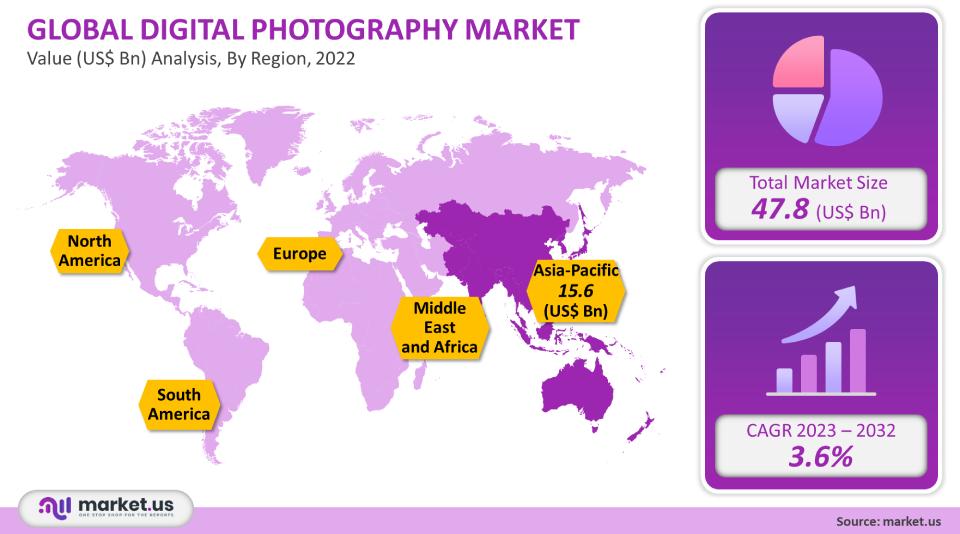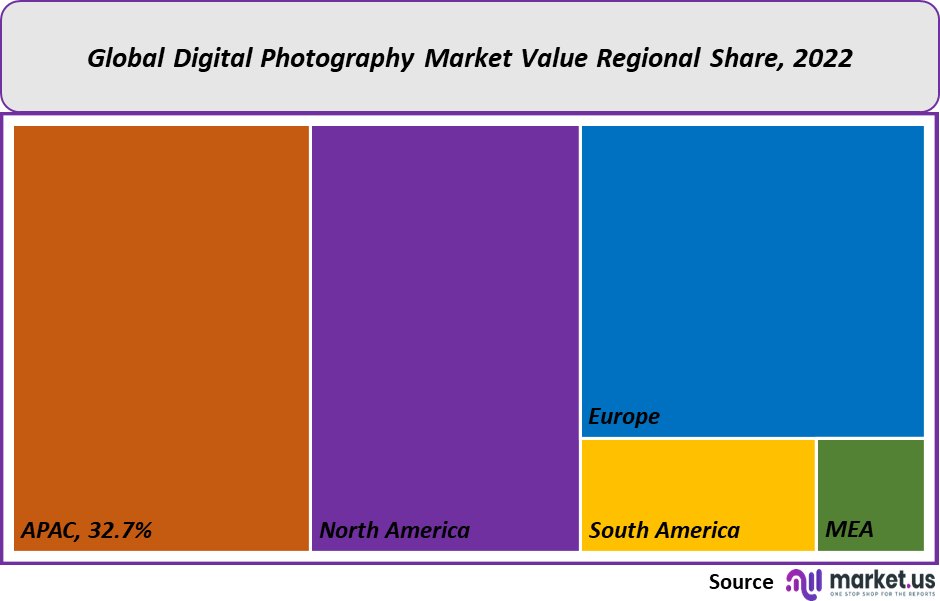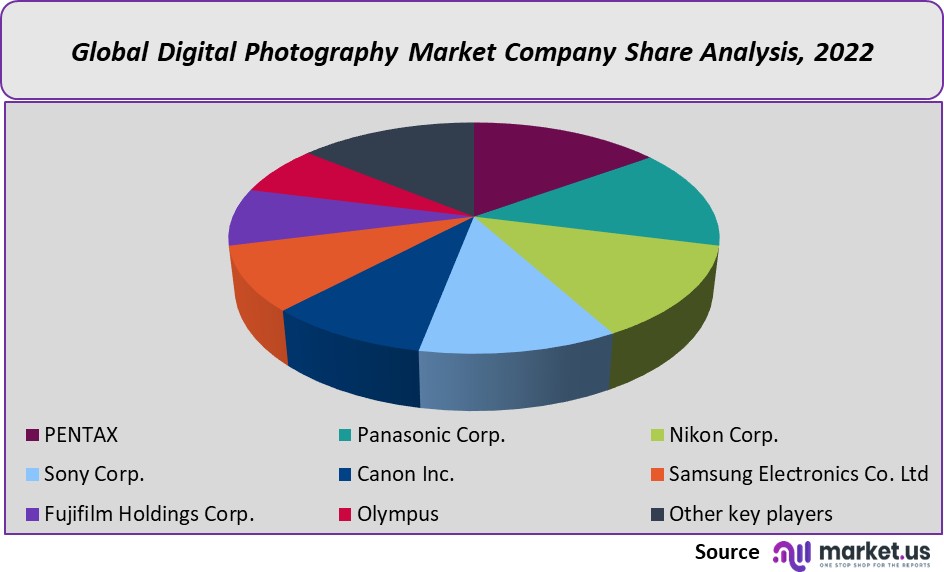Global Digital Photography Market By Type (Photo Processing Equipment , Interchangeable Lenses), By Application (Photography Software , Photo Looks), By Region and Companies - Industry Segment Outlook, Market Assessment, Competition Scenario, Trends and Forecast 2023-2032
- Published date: May 2023
- Report ID: 67487
- Number of Pages: 209
- Format:
- keyboard_arrow_up
Quick Navigation
Report Overview
The global digital photography market is valued at USD 47.8 billion in 2022. It is expected to reach USD 68.08 billion at a 3.6% CAGR between 2023 and 2032. Digital photography responds since the image is gained instantly once it is captured.
Social media platforms, such as Instagram, have enflamed the scope for photography amongst many operators globally, with several shooting images with proficient DSLRs. The study’s scope focuses on global market analysis for digital cameras.
Developing digital media is varying the field of photo sharing, photography, blogging sites worldwide, and networking websites, creating profitable business chances for the development Digital Photography Market. Furthermore, the substantial number of people who use social media, including Facebook and the internet, young people, and the fashion of uploading pictures on several social media platforms, is anticipated to lead the digital photography industry.

Action photography has also improved sales of GoPro small digital cameras. Social media platforms, including Instagram, have enlarged the scope for photography among various users worldwide. Most users click images with proficient DSLRs and post them to the app rather than just clicking photos with their phones.
A digital photograph is a photo taken using digital imaging technology. Digital photography includes gaining photographs that employ devices. Focused on a lens, it comprises a light-responsive sensor array. Furthermore, the detention photos are in digital format and are saved as a computer file. Photographs seized by digital photographs are saved in electronic memory devices and then corrected, resized, and modified.
Digital photography offers a response because the image is accessed instantly once it is captured. To record the image, this type of photography depends on electronic sensors. The captured image is stored as a digital file; it can be seen on a computer or printed out. This type of photography proposes several benefits over traditional film photography, with the capability to store numerous images on a sole storage device without the need for the darkroom to print photos and edit images using the software.
Global Digital Photography Market Scope:
Type Analysis
Photo processing equipment is a machine used to print and develop photographs. This gear can be utilized to process both film-based and digital images. A photo-processing lab is usually a dark room with slight to no light. This is essential as the light will ruin the unripe film and can cause the photographs to fade. Interchangeable lenses are known as dioptric lenses.
These lenses have superior power compared to traditional lenses. Used in ophthalmic applications, including cataract surgery and refractive errors. A camera phone can capture photos. It is a camera that is combined with a phone. It is usually a low-resolution camera of fewer than five megapixels. It is because the emphasis is on the phone’s affordability and portability more than on its photographic abilities.
Application Analysis
The photography software application segment will dominate the global digital photography market in 2022, accounting for around 60.23% of the entire revenue. The development can be attributed to the growing demand for processing and editing digital photos utilizing several software applications installed on laptops or PCs.
Numerous photo-editing applications, including Nik Software Raw Therapee, Corel Paint Shop Pro, and Adobe Photoshop, are broadly utilized across all age groups worldwide due to their high-end features and ease of use attached with progressive technology stages that support the 64-bit architecture, which is essential for handling huge data files created from digital cameras.
Key Segments:
By Type
- Photo Processing Equipment
- Interchangeable Lenses
- Camera Cell Phones
By Application
- Photography Software
- Photo Looks
- Photo Processing
Market Dynamics:
Market Drivers
- Growing demand for digital photography from the expert segment as it delivers high-quality videos and images. The explosion of smartphones and other mobile devices with progressive camera functions is fueling the development of the digital photography market.
- Rising demand for photo editing and post-processing software is also contributing to the growth of this industry. The rising popularity of social media platforms, including Twitter, Facebook, and Instagram, pushes the global demand for digital photography services.
- The growing acceptance of drones for capturing aerial videos and photos is the primary motivation for developing the global digital photography market.
Restraints
- Digital photography is utilized in numerous industries, including surgery, production, medicine, and automobiles. These digital photography product lines are advanced, costly, and involve professional expertise. This factor is anticipated to slow the digital photography market’s substantial growth from 2023 to 2032.
- The disadvantages of using digital photography are Memory Card Difficulties, Higher Initial Cost, Battery Consumption, Image Resolution, Wide Range, Shutter lag, and Multiple Exposures are a few of the downstairs for digital photography.
Opportunities
- Fast-increasing applications of photography in a variety of fields, such as business, manufacturing (photolithography), scientific research, art, surveillance systems, entertainment, photojournalism, data storage, photo albums, medical visualization, machine vision, and automotive, are expected to drive significant development opportunities in the digital photography market through the forecasted period.
- Over the forecast period, it is expected that professional photographers will shift to digital photography more frequently.
Trends
- Digital media has transformed the face of digital photography with the emergence of blogging sites, networking sites, and photo-sharing sites. This improved involvement of massive populations. On the internet, it is valued as the key factor in spreading the demand in the digital photography market.
- Furthermore, the vital players in this market are continually innovating and introducing improved products to attract consumers. For instance, wireless cameras are anticipated to observe a surge in demand in the established markets of Europe, Japan, the U.S., and other developing economies in the Asia Pacific.
- Digital cameras and Video are anticipated to rapidly evolve into network devices, generating new chances for film suppliers and wireless operatives. With digital cameras retrieving the internet and personal computers via wireless data construction, new suitability levels for consumers.
- Digital media has transformed the world, networking, photo sharing, blogging, and other related markets, creating enormous business opportunities in the field of photography.
Regional Analysis
Regionally, the most significant digital photography’s largest market share is 32.7%, accounted for by the Asia-Pacific in 2022. The Asia Pacific has the major growing segment of the digital photography market. The increasing photography trend is the key factor leading to the demand for digital photography. Photography became affordable and extra user-friendly, continuing to back the region’s demand for digital photography in the projected period.
The development can be attributed to growing awareness about its benefits, increasing disposable income, consumer photography, and the rising popularity of digital devices. The growing saturation of digital devices in developing economies, including China and India, is also expected to boost concerned market development in the Asia Pacific region.
The regional analysis is given according to country level in North America, Europe, Asia Pacific, South America, Middle East Africa, etc.

Key Regions and Countries covered in the report:
- North America
- The US
- Canada
- Mexico
- Europe
- Germany
- The UK
- France
- Italy
- Russia
- Spain
- Rest of Europe
- APAC
- China
- Japan
- South Korea
- India
- Rest of Asia-Pacific
- South America
- Brazil
- Argentina
- Rest of South America
- MEA
- GCC
- South Africa
- Israel
- Rest of MEA
Major companies in this industry primarily focus on the expansion of their respective capacities as well as potential mergers & acquisitions.
The key players accept key strategies, including geographical expansion, product development, mergers and acquisitions, and many other methods to increase the demand for digital photography market. Major key companies included in this market are PENTAX, Panasonic Corp, Canon Inc, and others.

Digital Photography Market Key Players:
- PENTAX
- Panasonic Corp.
- Nikon Corp.
- Sony Corp.
- Canon Inc.
- Samsung Electronics Co. Ltd
- Fujifilm Holdings Corp.
- Olympus
- Kodak Co.
- Other Key Players
These are the major players in the digital photography market.
For the Digital Photography Market research study, the following years have been considered to estimate the market size:
Attribute Report Details Market Size in 2022
USD 47.8 billion
Growth Rate
3.6%
Forecast Value in 2032
USD 68.08 billion
Historical Years
2016-2020
Base Year
2021
Estimated Year
2022
Short Term Projection Year
2028
Projected Year
2023
Long Term Projection Year
2032
Report Coverage
Competitive Landscape, Revenue analysis, Company Share Analysis, Manufacturers Analysis, Volume by Manufacturers, Key Segments, Key company analysis, Market Trends, Distribution Channel, Market Dynamics, COVID-19 Impact Analysis, strategy for existing players to grab maximum market share, and more.
Regional Scope
North America, Europe, Asia-Pacific, South America, Middle East & Africa
Country Scope
United States, Canada and Mexico, Germany, France, UK, Russia and Italy, China, Japan, Korea, India and Southeast Asia, Brazil, Argentina, Colombia etc.Saudi Arabia, UAE, Egypt, Nigeria and South Africa
Frequently Asked Questions (FAQ)
What will be the market size for Digital Photography Market in 2032?In 2032, the Digital Photography Market will reach USD 68.08 billion.
What CAGR is projected for the Digital Photography market?The Digital Photography market is expected to grow at 3.6% CAGR (2023-2032).
Name the major industry players in the Digital Photography market.PENTAX, Panasonic Corp., Nikon Corp., Sony Corp., Canon Inc., and Other Key Players are the main vendors in Digital Photography.
List the segments encompassed in this report on the Digital Photography market?Market.US has segmented the Digital Photography market by geographic (North America, Europe, APAC, South America, and MEA). By Type, market has been segmented into Photo Processing Equipment, Interchangeable Lenses, and Camera Cell Phones. By Application, the market has been further divided into, Photography Software, Photo Looks, and Photo Processing.
What are the main business areas for the Digital Photography market?APAC and North America are the largest market share in Digital Photography Market operates.

- PENTAX
- Panasonic Corp.
- Nikon Corp.
- Sony Corp.
- Canon Inc.
- Samsung Electronics Co. Ltd Company Profile
- Fujifilm Holdings Corp.
- Olympus
- Kodak Co.
- Other Key Players
- settingsSettings
Our Clients
| Single User $4,599 $3,499 USD / per unit save 24% | Multi User $5,999 $4,299 USD / per unit save 28% | Corporate User $7,299 $4,999 USD / per unit save 32% | |
|---|---|---|---|
| e-Access | |||
| Report Library Access | |||
| Data Set (Excel) | |||
| Company Profile Library Access | |||
| Interactive Dashboard | |||
| Free Custumization | No | up to 10 hrs work | up to 30 hrs work |
| Accessibility | 1 User | 2-5 User | Unlimited |
| Analyst Support | up to 20 hrs | up to 40 hrs | up to 50 hrs |
| Benefit | Up to 20% off on next purchase | Up to 25% off on next purchase | Up to 30% off on next purchase |
| Buy Now ($ 3,499) | Buy Now ($ 4,299) | Buy Now ($ 4,999) |











